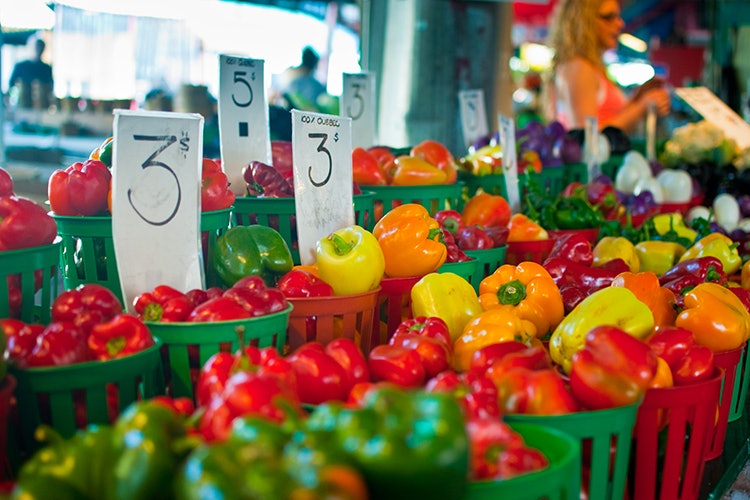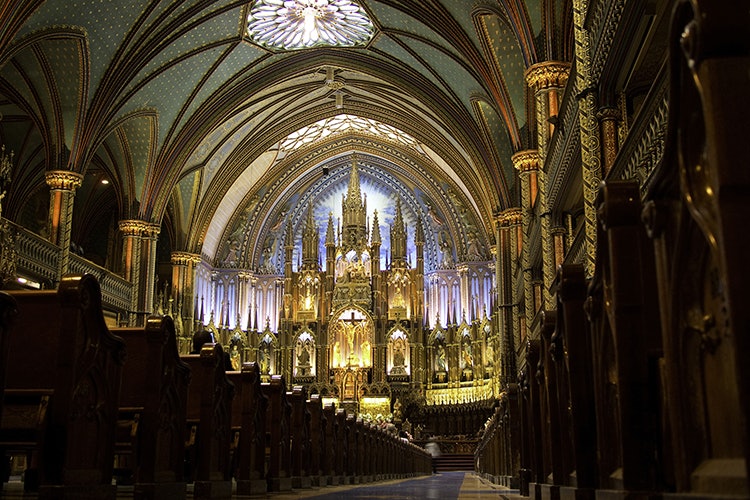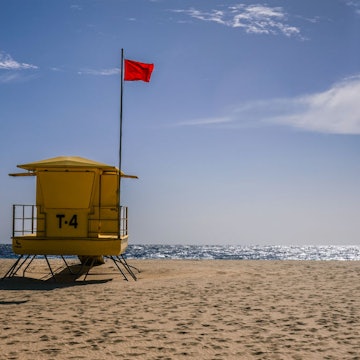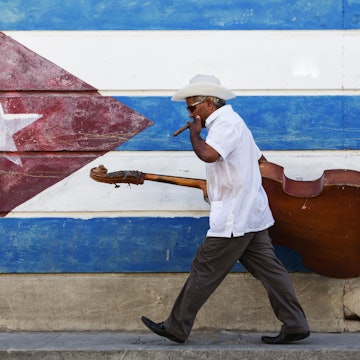

Montréal skyline from Mont Royal. Image by Wei Fang / Moment / Getty
Bold, brazen and beautiful, Montréal is a tantalizing tale of two worlds: new-world energy and excitement meets old-world glamour and grace. Take in the best of both while sipping a creamy café au lait on a Parisian-style sidewalk terrasse. Canadienne to the core, with its pristine urban streets and pockets of wild nature, Montréal is also a hub of Québecois culture, adrift in North America's vast sea of Anglophonia.

Peel back the layers of the city’s identity by sampling unique regional fare, wandering history-laden streets in Old Montréal and pondering colonial French influences manifest in elaborate churches and vast swaths of colourful terraced houses. And after the lights go down, Montréal has yet another trick up its sleeve: a vibrant and boisterous nightlife second to none. From a thriving gay district to a rampant indie music scene to a chock-a-block summertime festival schedule – not to mention all the bars, clubs, and pubs that explode after dark – Montréal is a haven for hedonists.
Stats
Population: 1.6 million
Visitors per year: about 8.4 million
Language: Primarily French, but English is also spoken
Daily budget: $200 for mid-range hotel and restaurant meals
Distance to/from Toronto: 543.2 km
Driving time to/from Toronto: about 5.5 hours
Best time of year to go: June–August
Number of Montréal streets with 'Saint' in their name: 152
Neighbourhoods
Downtown
Cosmopolitan and urban in nature, this area is where the business district collides with shopping malls, overflowing restaurants and a few heavy-hitting tourist attractions. Culture buffs seeking Canadian and Québecois art have two solid choices: traditional and classic pieces at the Musée des Beaux-Arts or cutting-edge modern masterpieces at the Musée d’Art Contemporain. Almost 200 years old, McGill University invites roaming types to admire its well-tended campus, tidy collection of turreted Victorian buildings, and impressive alumni roster – including the likes of Leonard Cohen and William Shatner. Head south on wide McGill College Avenue, passing the iconic Illuminated Crowd sculpture, to Rue St. Catherine (the city’s main retail corridor). Go east, swinging south at busy thoroughfare St. Laurent for Chinatown, or continuing dead east for the Village, Montréal’s gay district. Get a taste of Montréal’s infamous nightlife at the rooftop of Sky Pub & Club, with its iconic Jacuzzi and pool, or take in a raucous drag show at Mado Cabaret.

Plateau/Mile End
Artists, scholars and counter-culture types fill out this pretty district, which is home to the city’s pride and joy: the sprawling expanse of Parc du Mont Royal. Take the day to explore its peak-top Lac des Castors (a great skating spot in winter) and the panoramic views from Kondiaronk Lookout. If it’s Sunday, check out the drummers and dancers at the ‘tam tams’, a hippie hangout in the northeastern section of the park, near the George Étienne Cartier Monument. Cap off a day of wandering through greenery with dinner in a bring-your-own-wine bistro or candlelit hole in the wall. Try every form imaginable of foie gras, and other local favorites, at Au Pied de Cochon; for more classic French flair, L’Express is a good call. To sample culinary influences of another kind, brave the lines at the renowned smoked meat deli, Schwartz’s, or Montréal’s cherished St. Viateur Bagel, which is open 24/7 in case you get a late-night carb craving.

Little Italy
Fuel rambling walks around this leafy area with fortifying shots of espresso in sports bars that blast Italian soccer around the clock. Your only dilemma during a trip to this northern reach of Montréal is deciding where to eat. For an authentic old-school ristorante experience, you can’t do better than devouring the chalkboard specials at Lucca (www.restaurantlucca.ca). Or hit Montréal’s locavore haven, Marché Jean Talon, where you can simply wander and graze on French pastries, artisanal local cheeses, regional wines, and smoked meats.

Old Montréal
Breathtakingly well-preserved colonial architecture, public squares bursting at the seams, artists selling their wares, and romantic cobblestoned alleyways – you can find them all here in Montréal’s preserved historic quarter. To get a deeper feel for the city’s tumultuous past, prioritize Place d’Armes, a colonial battleground that today gathers some of the most beautiful heritage buildings in the city – including the stained-glass Gothic Revival Basilique Notre-Dame. As the epicenter of the city’s high-luxury boutique hotel culture, you might want to beg, borrow or steal to get a room here, where the typical vibe is 19th-century architecture meets contemporary comfort. Good bets for first-time visitors include the crisp and chic Hôtel Gault or antique-heavy Bonaparte.

Olympic Park and Around
If you have kids in tow, or you’re one of those list-checking types, you can cross off at least four big sites at the Olympic Park, an east-end hub of tourist frenzy. The butterflies at the Jardin Botanique & Insectarium, penguins at the Biodôme, scenic bi-level funicular at the Olympic Stadium and cutting-edge sound-and-light shows at the Rio Tinto Planetarium will all vie for your attention. To fuel your day of fun, check out the local food stalls at the handsome Beaux-Arts Marché Maisonneuve.

Need to Know
Packing
Montréal is known for its climate extremes: in the dead of winter, when the temperatures dip far below zero, you’ll need warm jacket, scarf, hat and gloves. And don't forget your boots – Montréal's snowfall can be unforgiving. The summer months bring heat and humidity and even shorts and t-shirts can be uncomfortably hot. Keep in mind that Montréalers are a stylish bunch and you won’t get past the bouncers at the hottest clubs if you’re wearing athletic shoes.
Getting Around
Sky-high parking rates make driving in the city prohibitively expensive and the myriad one-way streets and all-French signage make it downright stressful. Stick to taxis – hail one right on the street and tip at least 10% – or the expansive bus and subway system (www.stm.info/en).
Etiquette
Montréal isn’t Canada’s only bilingual city, but it’s the only one where you’ll hear both languages in equal measure. Stick to the main sights and centrally located restaurants and hotels and you’ll have no problems getting by in English. But if you know a few French phrases, grab the chance to try them out – a valiant effort will be appreciated, even if you don’t know your tu from vous or le from la.
Booking Ahead
In the summer months, June to September, a day doesn’t go by without a festival happening somewhere in the city. Book months in advance if you plan to visit during this time, especially if you want to stay close to all the action. Old Montréal and Downtown hotels will fill up first – and fast.
Sarah Richards is a freelance writer who writes about Montréal and the rest of Québec for the Lonely Planet Canada guide.















